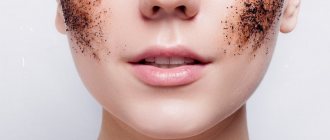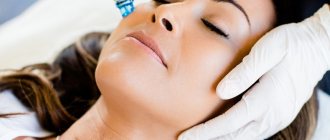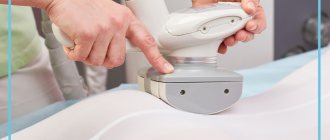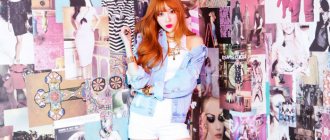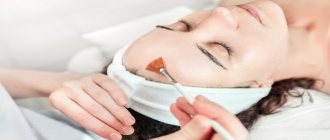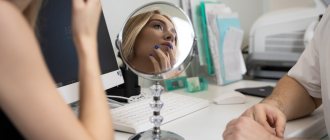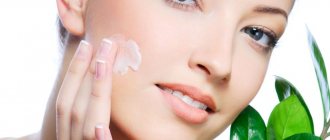Photorejuvenation is a hardware rejuvenation method based on intense pulsed irradiation of the skin.
This procedure has a number of advantages over other methods. Firstly, photorejuvenation is a non-invasive procedure, as a result of which there is no long rehabilitation period. Secondly, it is painless and safe. There were no reported cases of complications or side effects. Thirdly, skin rejuvenation using the Lumenis M22 device has a prolonged effect. Under the influence of light waves, the processes of synthesis of substances necessary to prolong youth are launched in skin cells.
Photorejuvenation: the essence of the procedure
Photorejuvenation is a way to get rid of facial skin imperfections using a special device that emits light pulses of a given frequency and length.
The procedure is carried out by directing various attachments to problem areas. Pulses in contact with skin cells activate processes such as:
- synthesis of collagen and elastin;
- oxygen absorption;
- detoxification;
- death of pathogenic microorganisms;
- coagulation of blood vessels and their disappearance;
- destruction of pigment.
The intensity of the impact is adjustable.
The difference between phototherapy and laser therapy
Many patients do not see the difference between therapy using the Lumenis M22 IPL device and the Lutronic eCO2 laser, although these are radically different methods for eliminating age-related changes.
Phototherapy requires more fine-tuning, unlike fractional laser rejuvenation. When performing photorejuvenation, a cosmetologist can independently select the depth and intensity of exposure to light rays. Also, taking into account the characteristics of the patient’s skin, the maximum value of the flash energy, the number of pulses and intervals between them, and the duration of exposure to one flash are set.
IPL rays are used in another popular cosmetic procedure - photoepilation.
Indications for light rejuvenation procedures
Exposure to intense light pulses, otherwise known as IPL therapy, is effective for:
- the presence of age-related changes in the skin, which usually occur after 30 years (wrinkles, decreased firmness, elasticity, appearance of a double chin);
- problems with young skin that cannot be solved by any other method;
- unhealthy complexion;
- dry skin, peeling, tightness;
- hyperpigmentation (spots, freckles, melasma, etc.);
- vascular network;
- acne due to the ineffectiveness of drug treatment or as part of complex therapy;
- increased sebum production;
- enlarged pores.
Indications for use are quite extensive. However, only a doctor can predict the result in each specific case after examination and communication with the patient.
At what age is it better to do photorejuvenation?
An absolute contraindication is age under 16 years. Any traumatic effects on a teenager’s skin, combined with sudden changes in hormonal levels, can trigger the development of allergies, autoimmune diseases and even melanoma.
At the age of 17-25 years, any cosmetic defects are often perceived very painfully by young people. However, in the vast majority of cases, they are, albeit unpleasant, but temporary, and do not pose a danger to appearance in the future.
It is worth using skin phototherapy from at least 25-28 years of age, and according to foreign experts - even from 35 years of age.
At the age of 56 years and older, cosmetic defects are almost irreversible due to natural destructive changes in the skin, facial muscles and subcutaneous fat. In this case, phototherapy will at best give an insignificant and short-term result.
Otherwise, the light wavelength and intensity of the device do not depend on the patient’s age and are determined solely by the specifics and severity of the cosmetic defect.
List of contraindications
The desire for beauty is absolutely natural for a person, especially a woman. However, in the pursuit of perfection, you can do harm. To avoid health problems and irrational spending, contraindications to facial photorejuvenation should be taken into account:
- very dark skin by nature;
- recent tanning (no more than 2-3 weeks ago), use of self-tanning;
- acute dermatological and infectious diseases;
- herpetic rashes;
- oncopathology;
- blood diseases;
- presence of a pacemaker;
- pregnancy and lactation period.
The procedure is also not recommended in summer, when there is intense ultraviolet radiation. Combination with phototherapy can cause the opposite effect - hyperpigmentation.
Preventive measures to prevent aging processes
The most popular ways to prevent premature aging and slow down the natural process of “growing up” of the skin are the following:
- use of photoprotectors;
- hydration;
- maintaining a healthy lifestyle.
It should be noted that exposure to ultraviolet radiation is beneficial for the skin only in strictly dosed quantities. Considering that every person encounters UVR every day, as soon as he goes outside, it is quite difficult to calculate even the approximate dose of radiation he receives. Facial skin that is not protected by clothing suffers especially. It’s not for nothing that many skin care products today contain special photoprotective substances and UV filters. Thanks to their application to the skin, part of the radiation undergoes a chemical reaction and does not reach the dermal cells.
A normal level of hydration is another factor that contributes to long-term preservation of youth. Due to environmental influences, internal diseases, temperature and other phenomena, the skin constantly loses moisture, which leads to premature cell death, so the use of moisturizers for it not only prolongs youth, but also strengthens its natural protection.
As for a healthy lifestyle, it includes giving up smoking and alcohol, playing sports, spending time in the fresh air, as well as a normal, balanced diet, without overusing sweets, fried, fatty, spicy foods.
Pros and cons of the procedure
The main advantages of IPL rejuvenation methods are the following facts:
- low traumatic procedures;
- high effectiveness in the fight against skin imperfections;
- the ability to prevent the occurrence of defects, wrinkles, etc.;
- absence of pronounced discomfort during the procedure;
- do not leave scars after light exposure;
- do not require lifestyle changes or cessation of work;
- long lasting effect.
Photorejuvenation is an excellent cosmetic method to solve many aesthetic and medical skin problems. However, it is not without its drawbacks. Among them are:
- an impressive list of contraindications;
- unpleasant, albeit temporary, consequences of the procedure in the form of swelling, redness, itching in areas bordering the mucous membranes;
- inability to use cosmetics in the first 3-5 days after light exposure;
- risk of photodermatosis, manifestations of hypersensitivity.
What to choose – laser rejuvenation or IPL photorejuvenation?
“Laser rejuvenation” and IPL photorejuvenation are fundamentally different procedures, although they imply identical light exposure.
“Laser rejuvenation” should be chosen by those who want:
- Make the skin as even in tone and texture as possible;
- Smooth out creases and wrinkles;
- Tighten the skin;
- Eliminate scars and scars;
- Cure acne;
- Get rid of hyperkeratosis (excessive keratinization of the skin caused by insufficient or slow desquamation of epithelial cells);
Classic IPL should be chosen by those who want:
- Quickly and firmly “erase” pigment spots from the face;
- Eliminate large spider veins and networks.
- Remove a small amount of rosacea mesh;
- Narrow pores;
- Mattify and tone the skin.
The final decision regarding the choice of tactics to combat external imperfections should be left to the cosmetologist.
Preparatory activities
To prevent the development of complications after the procedure, doctors at our clinic recommend stopping tanning in any way 14-30 days in advance. You should protect your skin from exposure to UV rays, even if you are not going to the beach or solarium specifically for this. Cosmetics can help you.
You also need to stop taking for a month:
- non-steroidal anti-inflammatory drugs with antiplatelet properties;
- antibiotics;
- retinoids.
Nothing complicated. There are no other restrictions.
conclusions
Unfortunately, many cosmetologists and clinics, acquiring their own websites and other Internet resources, are increasingly misleading potential patients about certain procedures. There is no such thing as “laser photorejuvenation”, and you must remember this. This term is equivalent to mixing photoepilation and laser hair removal. And if you are offered “laser photorejuvenation” instead of laser rejuvenation, know: either this clinic does not have varied equipment and is deliberately confusing you with definitions, or, even worse, the cosmetologist himself does not understand the topic.
Striving for a positive result and health safety, choose a good cosmetologist and a clinic with licensed equipment.
Progress of the photorejuvenation procedure
All manipulations will take no more than 15-40 minutes. To begin with, the skin is cleansed with special non-aggressive products, then a gel is applied to it to facilitate the penetration of light rays and protect the epidermis and other tissues from overheating. To protect the cornea, the patient and doctor wear glasses. The doctor begins to work with attachments equipped with sensors. In this case, the patient does not experience severe pain, but the session cannot be called pleasant. There is a feeling of tingling, slight burning. To speed up regeneration and relieve redness, apply a cream with dexpanthenol.
Stages of implementation
Before a phototherapy session, the general state of health must be assessed. This is necessary to identify the full range of indications and possible contraindications to the use of this technique. In the absence of the latter, the cosmetologist begins to perform manipulations.
Skin phototherapy is carried out in 4 stages:
1. The specialist applies a gel to the areas exposed to radiation, which protects the skin and soft tissues from overheating.
2. The patient puts on special tinted glasses to protect the eyes from the bright light generated by the device.
3. The cosmetologist acts on problem areas with pulsed light.
4. At the end of the procedure, the specialist applies a special cream to the skin, which promotes rapid healing and restoration of the skin.
The duration of the session is no more than half an hour, on average - 7-9 minutes.
Rehabilitation period
Redness, swelling, and small bruises characteristic of the recovery period disappear on their own within 2-14 days. For most patients, rehabilitation takes 3-5 days. Some do not experience any unpleasant symptoms at all after the procedure. However, in any case, the skin is subjected to stress, and many processes associated with rejuvenation, cleansing, depigmentation, etc. begin to actively occur in it.
Therefore, doctors recommend:
- drink more purified water, since when the skin heats up, the liquid evaporates, and the rejuvenation process is impossible without hydration;
- give up/limit yourself from smoking (nicotine and other components of cigarette smoke and tar negatively affect the condition of blood vessels, complexion and neutralize the effect of the procedure);
- For about two weeks, avoid visiting the bathhouse, sauna, beach, or solarium.
If your general health deteriorates due to photorejuvenation, persistent swelling, hematomas and other symptoms, you should consult a doctor.
IPL facial photorejuvenation: pros and cons - appointment with a cosmetologist, contraindications to the procedure - MEDSI
Table of contents
- Photorejuvenation: what is it?
- Preparing for the session
- Indications for the IPL rejuvenation procedure
- Contraindications for photorejuvenation
- Advantages and disadvantages
- How is the procedure done?
- Number of procedures for excellent results
- How to care for your skin after the procedure?
- Cost of the procedure
- Advantages of carrying out the procedure at MEDSI
The way we look depends on many factors. And one of them is age. Time spares no one, it’s just that some are a little less lucky, and others a little more. But one day a person realizes that he is no longer young, that the skin is no longer as smooth and elastic as before, that wrinkles have appeared on it. It's no surprise that people who want to look more beautiful are closely pursuing technologies that promise a rejuvenating effect. One of them is IPL photorejuvenation.
Photorejuvenation: what is it?
IPL therapy, or IPL rejuvenation, is a modern technology based on the use of high-intensity light flux. The specialist uses a laser on the skin to activate collagen synthesis and speed up the process of cell renewal. As a result, the skin becomes smoother, it looks fresh, and wrinkles disappear. This technique makes it possible:
- Lighten, and in some cases completely remove sun and age-related skin defects
- Remove brown pigment spots, freckles
- Reduce the appearance of blush
- Lighten and reduce areas of redness, acne, dilated blood vessels
- Reduce marks from broken blood vessels on the face, chest and arms
- Improve skin texture, give it a youthful and healthy appearance, increase its tone
Preparing for the session
Photorejuvenation (IPL rejuvenation) is a procedure for which you need to prepare. Typically, the preparation looks like this:
- About a month before the start of the sessions, you must stop sunbathing.
- You should also stop using self-tanning products.
- If you are taking antibiotics or retinoids, you should stop taking them about a week before the procedure.
- It is necessary to stop taking non-steroidal anti-inflammatory drugs and medications containing aspirin, otherwise bruises may appear on the skin
- Makeup must be removed before the session
Detailed advice on preparing for the session can be obtained from a specialist. He will examine your skin, ask clarifying questions and make recommendations based on the individual characteristics of your body.
Indications for the IPL rejuvenation procedure
In what cases should this technique be used? The main indications for the procedure are:
- Age-related skin changes that most often appear after 30 years - the appearance of wrinkles, loss of firmness and elasticity, the formation of a double chin and jowls
- Problematic young skin - the procedure is recommended if the situation cannot be corrected in other ways
- Unhealthy complexion
- Dry skin, feeling of flaking and tightness
- Various pigment disorders - freckles, dyschromia, superficial form of melasma (the so-called mask of pregnancy)
- Vascular changes, formation of a capillary network
- Acne that cannot be cleared up with medication
- Increased skin greasiness
However, before deciding to undergo the procedure, you should consult with a specialist.
Contraindications for photorejuvenation
There are contraindications to IPL therapy sessions, and you need to read them carefully. The procedure is not performed in the following situations:
- Dark skin
- Tanning two to three weeks ago, using self-tanning products
- The presence of various skin diseases and inflammatory processes in the acute stage
- Presence of external signs of herpes
- Pregnancy and breastfeeding period
- Oncological diseases
- The presence of pathologies of the hematopoietic system
- Using a pacemaker
You also need to pay attention to what time of year is best for the procedure. It is better not to undergo IPL photorejuvenation in the summer, since ultraviolet radiation at this time has a particularly intense effect on the skin, and unwanted pigmentation may appear on it. The best option is autumn or spring, when the likelihood of complications is noticeably reduced.
Advantages and disadvantages
IPL facial rejuvenation is a technique that has many advantages. First of all, it is high efficiency. In just a few sessions, you can significantly improve the condition of your skin, get rid of wrinkles, age spots and acne, activate the skin renewal process, eliminate an unpleasant complexion, etc.
After the procedure there is no need to change your lifestyle. Rehabilitation does not take much time, which is especially important for those who live at a dynamic pace.
This technique also has disadvantages.
Firstly, people with sensitive skin may feel slight discomfort and a slight burning sensation during the procedure; they experience redness of the skin, which, however, goes away quite quickly.
Secondly, IPL rejuvenation of the face and other areas of the body does not solve the problem once and for all. It is advisable to carry out the procedure once a year.
How is the procedure done?
You must lie down during the procedure. A comfortable couch is provided for this purpose. To protect the eyes from light radiation, glasses or a special bandage are used.
A cool gel is applied to the area of skin that needs to be treated during the session. After this, the specialist applies flashes of light to the skin using a special device. Short photo flashes instantly heat problem areas to the temperature needed to activate collagen synthesis and destroy melanin pigment. In this case, the surrounding tissues are not affected.
The duration of the session depends on which areas of the skin need to be treated. Usually it is 15-20 minutes, less often – up to 40 minutes.
At the end of the procedure, a cream is applied to the skin, which has a soothing and protective effect.
Number of procedures for excellent results
For most people, 3-5 sessions are enough to get the maximum results from IPL photorejuvenation. The break between sessions is usually 3-4 weeks.
The effect can be felt after the first procedure. The skin becomes smooth, the number of pigment spots decreases, spider veins are no longer so noticeable.
A specialist will tell you the exact number of sessions you will need. In doing so, he will take into account factors such as the individual characteristics of the skin, the type of defects, as well as where and how they are located. In some situations, three sessions are enough, but more complex cases may require you to repeat the procedure not even five, but six or seven times.
How to care for your skin after the procedure?
The rehabilitation period after the IPL rejuvenation procedure usually lasts from 3 to 10 days. Follow the recommendations of specialists exactly to improve your well-being and avoid possible complications. After the session, redness of the skin may be observed for 2-5 days, and in rare cases, bruising may occur, gradually disappearing after 1-2 weeks.
Note:
- You can use cosmetics immediately after the session, but you must apply and remove makeup carefully
- Need to drink more
- We need to stop smoking
- For 2 weeks you need to avoid visiting a bathhouse or sauna, and do not take sunbathing.
- Before going outside, you need to apply a cream with a high SPF level to your skin.
- If you feel unwell, be sure to consult a doctor
Cost of the procedure
The cost of an IPL rejuvenation session depends on several factors. First of all, it is influenced by which area of the skin needs to be rejuvenated. A specialist will tell you the final cost of services after an individual consultation.
Advantages of carrying out the procedure at MEDSI
The MEDSI clinic has modern equipment designed to influence the skin for medicinal and aesthetic purposes. VIORA V-30 devices are used in our cosmetology offices. They provide maximum effect with a minimum of discomfort and discomfort.
Our specialists are ready to answer any questions regarding the IPL rejuvenation procedure. High qualifications and extensive experience give them the opportunity to conduct sessions in such a way as to successfully assist clients. They confidently solve even the most complex problems. From them you will receive the necessary recommendations on preparing for sessions and skin care after the procedure. We guarantee attentive attention and an individual approach to everyone who contacts us.
Are you planning to schedule a consultation? Call us at: +7 (495) 7-800-500.
Skin care after the procedure
To rid yourself of possible consequences such as photodermatosis, swelling, inflammation, and to prevent their occurrence, you must:
- in the first days, refrain from applying decorative cosmetics;
- to cleanse the skin, use only tonics and milks that do not contain alcohol;
- use medicinal and care gels, creams and ointments prescribed by a doctor;
- Go outside only after applying a high-SPF protection product.
Your skin could use support from the inside too. It is useful to take vitamin and mineral complexes, the composition of which is aimed at activating the process of regeneration, rejuvenation, strengthening blood vessels, etc.
Advantages of visiting the Seline clinic
Without undue modesty, we advise you to contact our clinic for a rejuvenation procedure using light energy. For this we have everything you need:
- The latest, always in good working order, reliable equipment comes from the USA and Europe. We purchase equipment for facial photorejuvenation in the maximum configuration, as well as additional attachments, which allows us to work with various, even the most delicate areas of the skin, and solve a wide variety of patient problems.
- Several service options. We perform photorejuvenation using the BBL device, which stops the aging process at the genetic level. We also have at our disposal a device from the American brand LUMENIS - M22 IPL. He solves many skin problems, transforming the patient as if caught in the crosshairs of a photo editor. Another useful service of our clinic is laser photorejuvenation using the Harmony XL device. The cooling nozzle of the device eliminates all the unpleasant sensations that may arise during the procedure.
- Doctors who have been trained to work with each device available in the clinic. They know exactly what parameters to set and how to process areas so that the result is maximum.
These are three good reasons to choose Seline Clinic. And the incredibly beautiful and comfortable environment of our medical facility will be a bonus.
Optimal number of sessions
The composition and duration of the course depend on the type and severity of cosmetic defects and are determined by a cosmetologist in each case individually. To remove local changes (spider veins, age spots), 1-2 procedures are sufficient. When eliminating wrinkles, preventing the appearance of acne in the future, or correcting sagging skin, 3, 6 or even 10 visits to a specialist may be required.
There must be a certain interval between sessions. On average, it ranges from 2 to 4 weeks and is determined individually by a cosmetologist.
FAQ
How to relieve swelling after the procedure?
Swelling is a normal reaction of the body to exposure to light. The permeability of the cell wall of the dermal vessels increases, the fluid leaves its previous place of residence and migrates. We see this as an increase in the size of certain areas of the face.
In the vast majority of cases, this reaction goes away on its own after 3-4 days. To alleviate the condition, you can use cold compresses, antihistamines (ask your doctor which ones), and soothing creams/gels. Herbs (herbal infusions) that have a diuretic and anti-inflammatory effect (for example, lingonberry leaves, erva woolly grass) also help relieve swelling.
Is it safe to do SMAS lifting after photorejuvenation?
These hardware procedures are perfectly combined. Photorejuvenation cannot affect the beauty of the oval of the face, eliminate sagging in the cheekbones, remove a double chin, or get rid of jowls. But ultrasonic SMAS lifting is capable of this. However, it is important to maintain an interval between procedures of 14-30 days.
Is it possible to do photorejuvenation after Botox?
Yes, you can. Botulinum therapy is effective against facial wrinkles and can prevent their appearance. And phototherapy copes well with age-related changes such as hyperpigmentation, uneven complexion, and “reformats” the skin into youth and beauty. However, the hardware procedure should be carried out 2-3 weeks after the injection. During this time, Botox will have time to “stand up” and maximize its effect blocking the transmission of nerve impulses.
What is forbidden to do after photorejuvenation?
After the procedure, you should not sunbathe, take a steam bath, sauna, drink alcoholic beverages, use aggressive cleansers, or medications without the consent of your doctor. It is important to take care of your skin, which has been exposed to intense light.
Methods and techniques for skin rejuvenation: photorejuvenation
Signs of aging are especially noticeable on the face - wrinkles and age spots, a “blurry” oval contour of the face, a gray, earthy skin tone, alas, do not add attractiveness at all.
In addition to various conservative ways to combat these manifestations, such as cosmetics for external use, as well as traditional medicine recipes, there are procedures developed by doctors and cosmetologists that help restore the properties of the skin, increase its elasticity, and smooth out wrinkles. All of them are divided into two main groups:
- surgical;
- hardware.
Surgical cosmetology involves performing appropriate operations to improve the condition of the skin.
Hardware methods of facial rejuvenation include:
- fractional rejuvenation;
- laser resurfacing;
- thermage;
- injection procedures;
- mesotherapy;
- ozone rejuvenation;
- photorejuvenation, and some other techniques.
